
September 15 - December 7, 2014
Curated by Christine Shaw
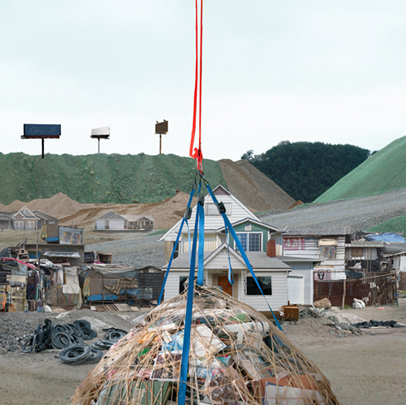
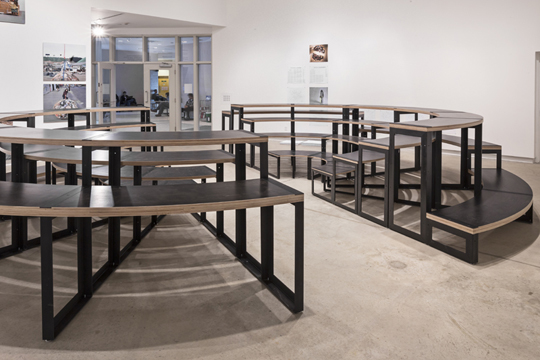
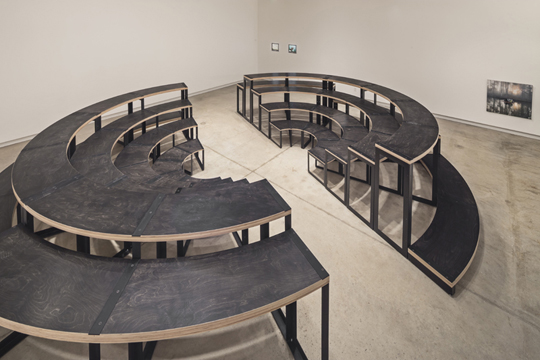
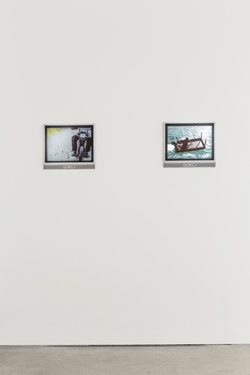

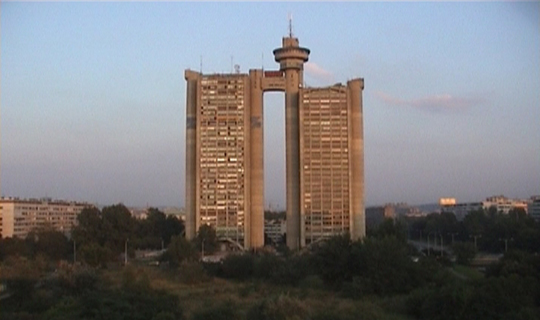
* All events are FREE and will take place in the Blackwood Gallery unless otherwise noted.
Opening Reception
Wednesday, September 17, 5 – 8pm
A FREE shuttle bus will depart from Mercer Union (1286 Bloor Street W.) at 5:30pm and return for 8:30pm.
Participation or Exploitation?
A Reading Group on Critical Perspectives on Social Media
September – November (Dates/Times TBD)
Hosted by the Institute of Communication, Culture, Information and Technology
Facilitated by Prof. Brett Caraway, Prof. Nicole Cohen, and Prof. Leslie Regan Shade
Join us for a five-session reading group on the politics and culture of social media, presented in conjunction with the Wages For Facebook campaign. For more information or to sign up for all or some of the sessions, please email nicole.cohen@utoronto.ca.
FREE Contemporary Art Bus Tour
Sunday, September 21, 12 – 5pm
The tour starts at Koffler Centre of the Arts at Artscape Youngplace (180 Shaw Street) at 12pm and then departs for Blackwood Gallery, Art Gallery of York University, and Doris McCarthy Gallery. To RSVP, email the Blackwood Gallery at blackwood.gallery@utoronto.ca by Friday, September 19 at 5pm.
Artist Talk: Mary Mattingly
Tuesday, September 23, 12:30 – 1:30pm
Annie Smith Mezzanine, Sheridan College (1430 Trafalgar Road, Oakville)
Mary Mattingly’s work collapses boundaries between performance, sculpture, architecture, and documentation. Her current projects are itinerant, small-scale architectural interventions that morph into pre-existing structures, reflecting city dwellers’ movements and exchanges while attempting to alter the despotic effects of economic development.
Pull: Participatory Performance with Mary Mattingly
Tuesday, September 23, 2 – 5pm: Mississauga to Oakville
Thursday, September 25, 9am – 12pm: Oakville to Mississauga
Help! Join artist Mary Mattingly in a collective pull of her 140lb spherical bundle of personal objects. As we pull, roll, and drag the boulder across the suburban terrain between Mississauga and Oakville, we will take stock of the environmental and societal impact of our personal consumption and the weight of our commodified world.
To participate, email blackwood.gallery@utoronto.ca by Friday, September 19 at 5pm.
Monitor 10: Performing the Political
South Asian Experimental Film + Video Screening
Wednesday, October 8, 1 – 4pm
Co-presented by the Centre for South Asian Civilizations and SAVAC (South Asian Visual Arts Centre)
Curated by Shai Heredia
From found footage to performance video, reality television to observational documentary, this set of videos is an investigation into how artists’ moving images perform the political. Join us for a screening and conversation on how cultural agents, with similar socio-political concerns, can create new forms of resistance. Artists include Shambhavi Kaul, Bee Thiam, Anahita Norouzi, The Youngrrr, Priya Sen, and WALA + Kush. For more information, please visit SAVAC’s website, http://savac.net/monitor-10.
FREE Contemporary Art Bus Tour
Sunday, November 2, 12 – 5pm
The tour starts at Justina M. Barnicke Gallery (7 Hart House Circle, Toronto) at 12pm, followed by a tour of the University of Toronto Art Centre. The bus then departs for Blackwood Gallery and the Art Gallery of York University. To RSVP, email Justina M. Barnicke Gallery at jmb.gallery@utoronto.ca by Friday, October 31 at 5pm.
FURNISHING POSITIONS: CONVERSATIONS
Saturday, November 22, 1 – 6pm
This hybrid event is part colloquium, part workshop, part performance, and part experiment. It is a support structure for the exchange of ideas. It is also part of Furnishing Positions. This event will assemble the contributors to the Furnishing Positions broadsheet series for conversations on the paradoxes of public space. Moderated by Adrian Blackwell.
Falsework is any temporary structure used to support a permanent structure during its construction until it becomes self-supporting. Falsework was formerly built in place, used once, and subsequently wrecked. The trend today, however, is toward increasing prefabrication, assembly in large units, erection by mechanical means, and continuing reuse of forms. These developments are in keeping with the expanding mechanization of production at construction sites and in other fields. Falsework has a short service life. No rules can be formulated which relate the size of a project to the standard of design and construction. Design should provide a fail-safe system. The legal responsibility of falsework is an important public consideration. The moral responsibility is shared by everyone concerned. Special precautions and safeguards should be identified. Falsework is required to carry dead loads, imposed loads, and environmental loads that are constantly changing. The risk of collapse should be minimized. Economic solutions to a falsework problem depend on time, experience, knowledge, and the consequences of failure. Good falsework must be paid for. Special problems may arise in relation to differing rates of strain and manufacturing tolerances. Unfavourable stresses may be created. Pay attention. Too often the importance of falsework is insufficiently recognized. (1)
- Christine Shaw, Director/Curator of the Blackwood Gallery
Download FALSEWORK poster
Vieques Videos
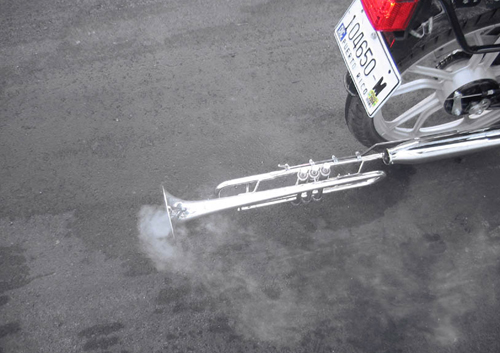
Allora & Cazadilla, Returning a Sound, 2004,
Single channel video with sound, colour, 5:44.

Photos courtesy of Allora & Calzadilla and Lisson Gallery.
Vieques, an inhabited island off Puerto Rico, was used by the United States Navy as a bomb-testing range from 1941 to 2003. The Navy was forced to evacuate after a civil disobedience campaign waged by local residents, with supporters from around the world. Over the course of a decade, Allora & Calzadilla contributed to the visual culture of this campaign with a long-term, multi-sited project including the Vieques Videos. Returning a Sound was made at the beginning of the process of demilitarization, decontamination, and future development, and at once celebrates a victory and registers its precariousness. The video addresses not only the landscape of Vieques, but also its soundscape, invoking the memory of the sonic violence of the bombing. It follows Homar, an activist, as he traverses the island on a moped with a trumpet welded to the muffler. Throughout his circuit, Homar acoustically reclaims areas of the island formerly exposed to ear-splitting detonations. Scarred with bomb-craters and with its ecosystem contaminated, the former military land has been designated as a federal wildlife refuge, a designation that entails further violence by marginalizing the demands of island residents for decontamination and municipal management—the point of departure for Under Discussion. In this video, an overturned conference table has been retrofitted with an engine and rudder from a small fishing boat. A local activist uses the motorized table to lead viewers around the restricted areas of the island, re-marking the antagonisms that haunt the picturesque coast and bearing witness to the memory of the Fishermen’s Movement, which initiated the first acts of civil disobedience against the ecologically damaging bombing practices.
Allora & Calzadilla live and work in San Juan, Puerto Rico. Born in Philadelphia, Pennsylvania, in 1974, Jennifer Allora received a BA from the University of Richmond in Virginia (1996) and an MS from the Massachusetts Institute of Technology (2003). Guillermo Calzadilla was born in 1971 in Havana, Cuba and received a BFA from La Escuela de Artes Plásticas, San Juan, Puerto Rico (1996) and an MFA from Bard College (2001). Collaborating since 1995, Allora & Calzadilla have magnified areas of political tension in the public realm through a wide-ranging body of work. They identify and stress the hairline fractures in societal systems—such as nationhood, environmentalism, states of war, and resistance—through performance, sculpture, sound, video, and photography. The artists represented the USA in the 54th Venice Biennale (2011). Solo exhibitions include Indianapolis Museum of Art (2012), the Museum of Modern Art, New York (2011), Haus der Kunst, Munich (2008), Stedelijk Museum, Amsterdam (2008), Kunsthalle Zurich (2007), and Walker Art Center, Minneapolis (2004). Among numerous group exhibitions, they participated in documenta 13, Kassel, Germany (2012), and the 29th São Paulo Biennial (2010).
Furnishing Positions
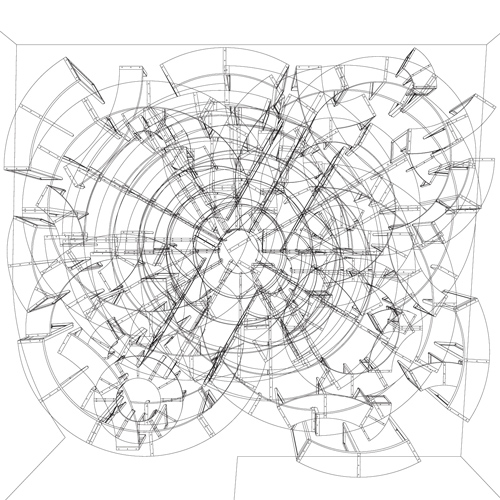
Courtesy of the Artist. Overlay of six drawings by Matthew Hoffman.
Adrian Blackwell creates discourse-machines: spaces of intellectual generosity, where bodies congregate, they move, think, and speak together, and they lay claim to a certain space as public space. (2) Blackwell’s commissioned project Furnishing Positions provides the falsework laying claim to the Blackwood Gallery as a public space. It is a modular sculpture that will be reconfigured six times; it is a broadsheet that will be published once every two weeks; and it is a set of conversations between the contributors to the broadsheets. With Furnishing Positions, Blackwell stages the paradox of public space according to six encounters: affinity and disagreement, representation and presentation, people and things, materiality and immateriality, privacy and publicity, and city and urbanization. By thinking of public space in terms of its essential polarities, a field of contestation is opened between extremes, providing a conceptual space for discussion and disagreement.
See Furnishing Positions for more details.
Desniansky Raion
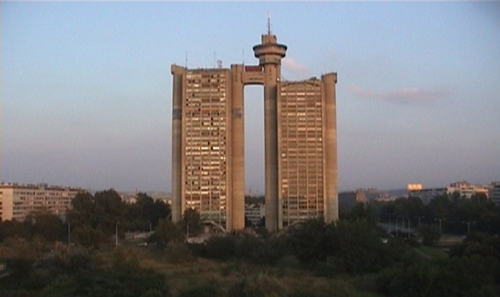
Copyright Cyprien Gaillard.
Courtesy of the artist / Sprüth Magers / Bugada & Cargnel / Laura Bartlett Gallery
Architecture in the work of Cyprien Gaillard generally appears only in its undoing, in its collapse. Desniansky Raion is set to the music of French composer Koudlam and captures the failed utopian aspirations of early twentieth-century buildings. The video opens with a shot of the Genex Tower, a colossal Brutalist building in Belgrade, Serbia, and then cuts to the parking lot of a drab housing complex in St. Petersburg, Russia, where we witness two large groups of men, fight clubs, clashing in a flurry of fists—an agonizing display of raw violence set against the stark backdrop of the housing project. The video then cuts to a spectacular detonation of a Parisian apartment complex accompanied by a lightshow, fireworks, and music, only to conclude with an aerial shot of a desolate, paltry housing complex in a district called Desniansky Raion in the suburbs of Kiev, Ukraine. As the video reveals, these and other modernist housing blocks found across the Western world once embodied notions of community, but soon came to be viewed as architectural eyesores and unsuccessful experiments in high-density housing. Gaillard isn’t simply re-litigating the impact of modernism in some overtly ironic commentary on its ethical and aesthetic value. Instead, the artist’s anodyne presentation of this ruined monument to modernist promise set to dance-hall-style music becomes an oblique meditation on how certain artifacts from the past continue to function in the contemporary moment in unforeseen ways. (3)
Cyprien Gaillard was born in Paris in 1980 and currently lives in New York and Los Angeles. He has been the recipient of a number of awards including the Preis der Nationalgalerie für Junge Kunst (2011), the Prix Marcel Duchamp and the Karl-Ströher-Preis (2010), the Prix academie les David (2010), the Prix Audi Talent Award (2007), the Aide individuelle à la création (2006), and the Aide à l'édition (2005). Solo exhibitions include MoMA PS1 (2013), Hammer Museum, Los Angeles (2013), Fondazione Nicola Trussardi, Milan (2012), Schinkel Pavillon, Berlin (2012), Centre Georges Pompidou, Paris (2011, 2008), KW Institute for Contemporary Art, Berlin, and Centre Georges Pompidou, Metz (both 2011), Zollamt/Museum für Moderne Kunst Frankfurt, and Kunsthalle Basel (both 2010). Major group shows include the Manifesta 10 - The European Biennial of Contemporary Art in St. Petersburg, Russia, the Institute of Contemporary Arts, London (both 2014), the National Museum of Art, Osaka, Japan (2013), the Kochi-Muziris Biennale in India (2012-2013), S.M.A.K. Gent and the Museum of Contemporary Art Chicago (both 2012), the 54th Venice Biennale, and Hamburger Bahnhof, Berlin (both 2011), Hirshorn Museum and Sculpture Garden, Washington, MoMA, New York, Gwangju Biennal, South Korea (all 2010), Tate Modern, Turbine Hall, London, and Generali Foundation, Vienna (both 2009), the 5th Berlin Biennale (2008), and the Biennale de Lyon (2007).
House and Universe
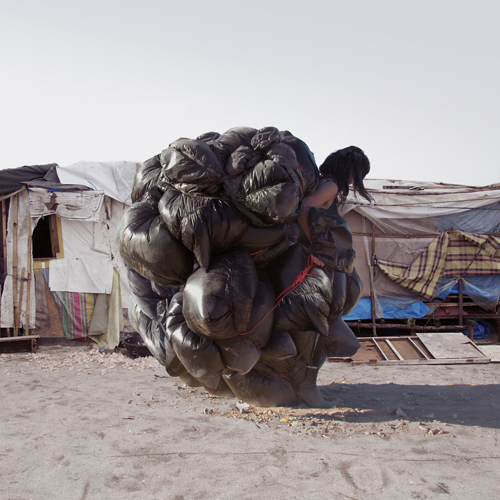
C-print photographs,
30 x 30 inches
Imagine a personal flying machine, equipped with jetpacks, that could collect dew from clouds to supply fresh drinking water to the traveller. Or moveable, public habitats whose forms are inspired by current global patterns of human migration, immigration, and pilgrimage. Or a futuristic, water-based floating city designed to mutate with the tides and serve at once as transportation, island, and residence. At the turn of the millennium, after three consecutive catastrophic floods prompted the privatization of water resources, Mary Mattingly took note and started drafting. And so began Mattingly’s mission to create imaginative-yet-practical solutions for imminent world change. Ecology, nomadic living, and community participation are central to Mattingly’s projects. The photographs that make up House and Universe depict her predictions for our collective dystopia should global warming and corporate privatization continue unabated.
Sphere
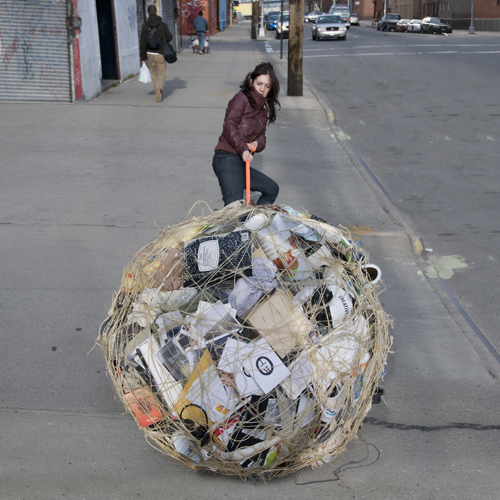
C-print photographs,
30 x 30 inches
As if to prepare for imminent catastrophe, Mattingly has been divesting herself of personal possessions. (4) Over several months, she archived every object she owns and traced their histories—“how it came into her life, its distribution via complex global supply chains, as well as where the raw materials for its manufacture were sourced.” Mattingly then bundled her personal property into a boulder-like sphere bound together by twine and dragged it across the Bayonne Bridge from Staten Island to Bayonne, New Jersey; and along King Street from Kitchener City Hall to Waterloo Public Square. For this performance, she (with help from the public) will pull it from Mississauga to Oakville, and back again.
Mary Mattingly is an artist based in New York. She has received grants and fellowships from the John S. and James L. Knight Foundation, the Harpo Foundation, New York Foundation for the Arts, the Jerome Foundation, Eyebeam Art+Technology Center, and the Art Matters Foundation. Mattingly’s work has been exhibited at the International Center of Photography, Seoul Arts Center, The New York Public Library, the Palais de Tokyo, and the deCordova Sculpture Park and Museum. She recently participated in MoMA PS1’s EXPO 1 with Triple Canopy Magazine and the smARTpower project in the Philippines with the U.S. Department of State and the Bronx Museum of the Arts. Her work has been featured in Aperture, Art in America, Artforum, ArtNews, Sculpture, The New York Times, The Financial Times, Le Monde Magazine, The New Yorker, The Wall Street Journal, and on BBC News, MSNBC, Fox News, News 12, NPR, WNBC, New York 1, and PBS’s Art21. Her writings were included in Nature, edited by Jeffrey Kastner, in the Whitechapel Documents of Contemporary Art series. In 2012, she launched the Flock House Project: three spherical living-systems choreographed throughout New York City’s five boroughs. Mattingly also founded the Waterpod Project, a barge-based public space containing an autonomous habitat that migrated through New York’s waterways.
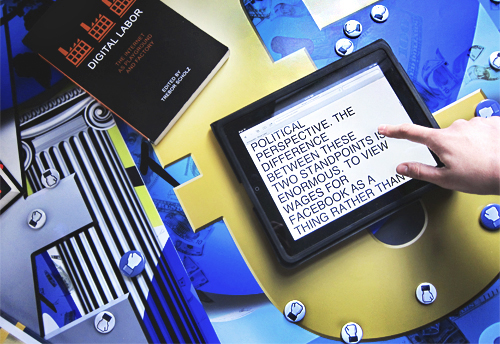
Wages For Facebook draws on the 1970s feminist campaign Wages For Housework to think through the relationships of capitalism, class, and affective labour at stake within social media today. Wages For Housework demanded that the state pay women for their unwaged housework and care-giving, as the market economy was built upon massive amounts of this unacknowledged work—and its labourers could be seen to constitute a huge working class. Wages for Housework built upon anticolonial discourse to extend the analysis of unwaged labour from the factory to the home. Along these lines, Wages For Facebook attempts to extend the discussion of unwaged labour to new forms of value creation and exploitation online. The launch of a manifesto website, wagesforfacebook.com, in January 2014 clearly hit a collective nerve. Since then the project has been debated widely via social media, at universities, and in the press, setting off a crucial public conversation about workers’ rights and the very nature of labour, as well as the politics of its refusal, in our digital age.(5)
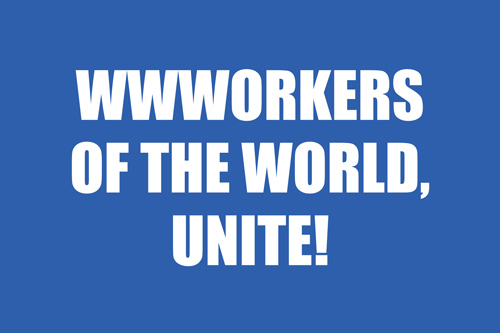
Excerpted text from the Wages For Facebook manifesto is presented on a backlit billboard as one element of a campus-wide campaign at the University of Toronto Mississauga which includes wallpapering the campus with speculative campaign posters; staging information tables staffed by (waged) Work-Study students; installing a digital labour reading room in the Hazel McCallion Academic Learning Centre; giving away free buttons that feature the motto WWWORKERS OF THE WORLD, UNITE!; flyering the campus with the text from hundreds of tweets discovered online voicing both support and criticism of Wages For Facebook; hosting a reading group on the politics and culture of social media; organizing a discussion-based workshop with Laurel Ptak on the political precedents for Wages For Facebook; and collectively exploring the possibility of building a workers’ centre on campus.
See Wages For Facebook for complete campaign details.
As soon as the site wagesforfacebook.com launched in January 2014 it was graced with over 20,000 views (and counting) and rapidly and internationally debated on social media platforms and message boards, as well as in mainstream and left press including The Nation, International Business Times, Dissent, The Atlantic, Jacobin, and The Hindu. It has been analyzed at conferences by academics across disciplines of geography, cultural studies, anthropology, public health, and labour; used to support the argument for Universal Basic Income by Pirate Party enthusiasts in Europe; spawned an activist group ready to collectivize and make the demand for wages for Facebook; is being taught to students in universities internationally; and is the subject of workshops and installations in the art context taking place in Chicago, London, New York, San Diego, San Francisco, and Stockholm. Wages For Facebook contributors and supporters include Eric Nylund, Michelle Hyun, Christina Linden, Anna Lundh, Pedro Neves Marques, Laurel Ptak, Christine Shaw, Mariana Silva, Nicole Cohen, as well as numerous University of Toronto Mississauga students, staff, and faculty.
Generously supported by the Canada Council for the Arts and the Ontario Arts Council.
![]()

With additional support from:

![]()


Student Housing & Residence Life, University of Toronto Mississauga
Special thanks to:
John Armstrong, Baseer Baig, Michael Beynon, CAFKA, Nicole Cohen, Alison Dias, Paul Donoghue, Gordon Hatt, Matthew Hoffman, Karie Liao, Lisson Gallery, Jeffrey Malecki, Robert Martins, Dax Morrison, Prefix Institute of Contemporary Art, Danny Russell, Sprüth Magers (Berlin), Alison Syme, Samson Tam, Joseph Taylor, Peter Urbanek, Andrew Veglio, and most of all, the artists.